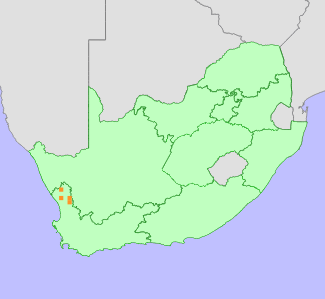|
Scientific Name | Eriospermum titanopsoides P.L.Perry |
Higher Classification | Monocotyledons |
Family | RUSCACEAE |
National Status |
Status and Criteria | Endangered A4bd; B1ab(iii,iv,v)+2ab(iii,iv,v) |
Assessment Date | 2022/08/03 |
Assessor(s) | N.N. Mhlongo & A. Harrower |
Justification | This species has a limited distribution range and has an extent of occurrence (EOO) of 1552 km², and an area of occupancy (AOO) of 32 km². It is known from three locations and the population is declining due to illegal collection for the specialist horticultural trade. More than 50% of the population will have been lost, due to collecting, over a three generation period (15 to 30 years) starting in 2010 to 2025-2040. The remaining population is potentially threatened by mining, quarrying, overgrazing and drought. It therefore qualifies as Endangered under criteria A and B. |
Distribution |
Endemism | South African endemic |
Provincial distribution | Western Cape |
Range | This species is endemic to the Western Cape Province, where it occurs in the northern and southern parts of the Knersvlakte. |
Habitat and Ecology |
Major system | Terrestrial |
Major habitats | Namaqualand Spinescent Grassland, Vanrhynsdorp Gannabosveld, Knersvlakte Shale Vygieveld, Knersvlakte Quartz Vygieveld |
Description | Plants can be found growing in quartz patches on shale. |
Threats |
| An illegal trade in habitat-collected plants of this species has developed in recent years. The population is declining rapidly as a result of illegal collection with over 494 plants included in confiscations between March 2019 and December 2021. A photograph of a consignment containing hundreds of plants of this species was observed in August 2021 indicating that many more plants are likely to have been removed from the wild but are not intercepted by law enforcement efforts. The species is also potentially threatened by mining, quarrying, drought and overgrazing. |
Population |
This species is a very localized habitat specialist and subpopulations consist of a few scattered plants. The plants are very cryptic and can easily be overlooked and there may therefore be more plants in the wild than are currently reported. The population is declining rapidly due to illegal collection. A recent poaching event in one of the localities removed a large majority of the plants and it is suspected that certain subpopulations may already be completely wiped out by collecting.
|
Population trend | Decreasing |
Assessment History |
Taxon assessed |
Status and Criteria |
Citation/Red List version | | Eriospermum titanopsoides P.L.Perry | VU D2 | Raimondo et al. (2009) | | Eriospermum titanopsoides P.L.Perry | Rare | Hilton-Taylor (1996) | |
Bibliography |
Hilton-Taylor, C. 1996. Red data list of southern African plants. Strelitzia 4. South African National Botanical Institute, Pretoria.
Perry, P.L. 1994. A revision of the genus Eriospermum (Eriospermaceae) Contributions from the Bolus Herbarium 17:1-320.
Raimondo, D., von Staden, L., Foden, W., Victor, J.E., Helme, N.A., Turner, R.C., Kamundi, D.A. and Manyama, P.A. 2009. Red List of South African Plants. Strelitzia 25. South African National Biodiversity Institute, Pretoria.
Snijman, D.A. 2013. Plants of the Greater Cape Floristic Region 2: The extra Cape flora. Strelitzia 30. South African National Biodiversity Institute, Pretoria.
|
Citation |
| Mhlongo, N.N. & Harrower, A. 2022. Eriospermum titanopsoides P.L.Perry. National Assessment: Red List of South African Plants version 2024.1. Accessed on 2025/12/13 |
 Comment on this assessment
Comment on this assessment


